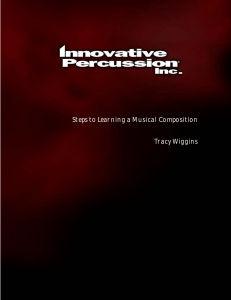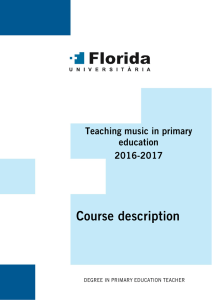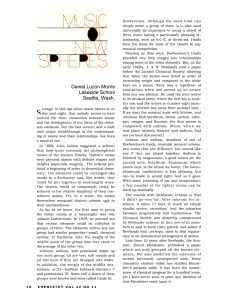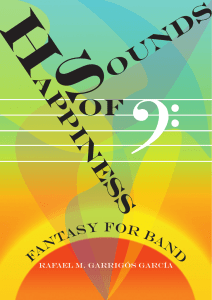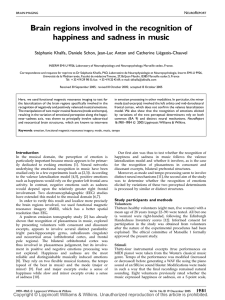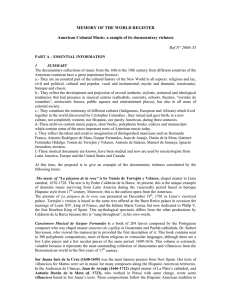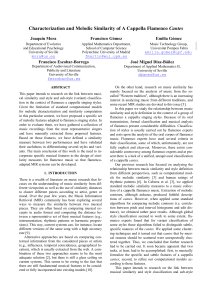The nature of music
Anuncio
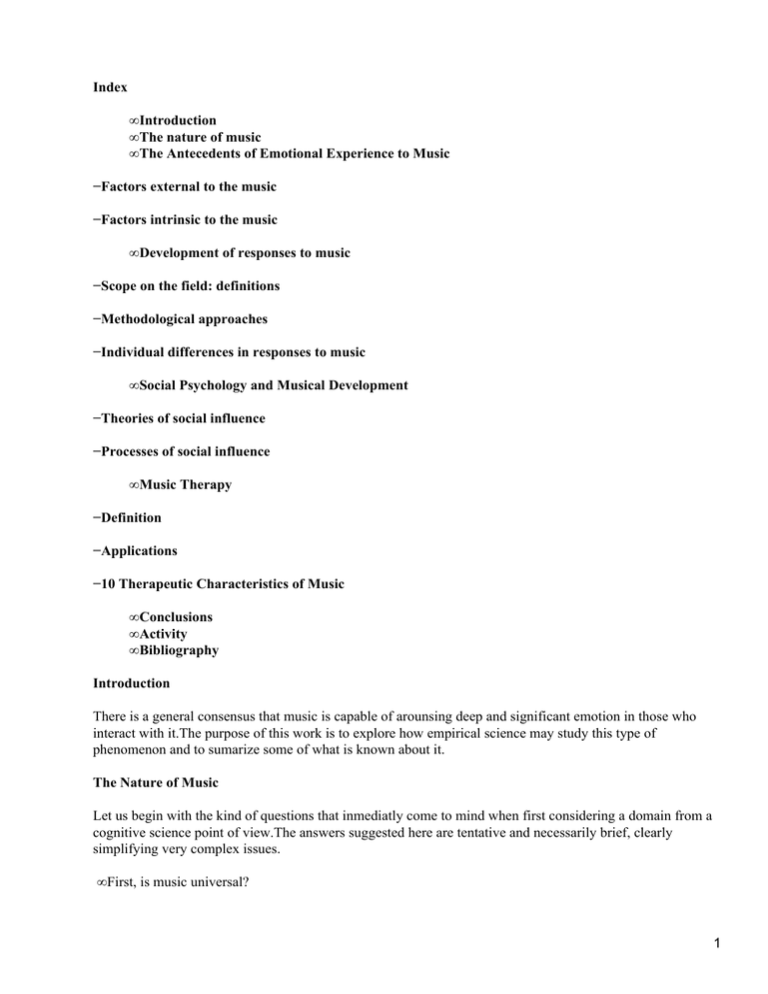
Index • Introduction • The nature of music • The Antecedents of Emotional Experience to Music −Factors external to the music −Factors intrinsic to the music • Development of responses to music −Scope on the field: definitions −Methodological approaches −Individual differences in responses to music • Social Psychology and Musical Development −Theories of social influence −Processes of social influence • Music Therapy −Definition −Applications −10 Therapeutic Characteristics of Music • Conclusions • Activity • Bibliography Introduction There is a general consensus that music is capable of arounsing deep and significant emotion in those who interact with it.The purpose of this work is to explore how empirical science may study this type of phenomenon and to sumarize some of what is known about it. The Nature of Music Let us begin with the kind of questions that inmediatly come to mind when first considering a domain from a cognitive science point of view.The answers suggested here are tentative and necessarily brief, clearly simplifying very complex issues. • First, is music universal? 1 Music is universal in the sense that all known cultures have some form of music.This may seem surprising to many at first because in our own culture we tend to leave the business of making music to a few individuals and consider it a special ability restricted to those individuals.Our culture may,in fact ,be one of the most extreme in the degree to which musical participation is limited. • Second,why do we have music anyway?Does it serve any obvious adaptive function? I woul say no single function seems to be served , but rather,different cultures emphasize diverse possible functions to a variety of degrees .In addition to the aesthetic function,music is used to mark social groups or hierarchies within groups.it is used in ritual and religion, as well as for communication and commercial purposes.It produces strong emotional effects and engages intricate perceptual and cognitive processes.With regard to the latter,studying music enables us to expand our understanding of human thought. • Third, are there structural universals in music ,cross−culturally and historically? Music varies widely,and althoguh there are no absolute invariants,some general tendencies can be identified. • The fourth question:what does music mean?Does music signify anything outside itself? There are different,sometimes widely divergent,opinions on this topic.Some commentators have suggested that music has iconic functions in that it stimulates objects or events in the world,such as birds singing,brooks babbling, and so on.Others have suggested that music simulates in some way emotional states such as joy and sorrow.So, it would seem that the meaning of music resides primarily in the relationships between musical events themselves rather than between musical events and nonmusical entities. • This brings us the fifth question,which is whether there is something like a musical syntax or grammar.Here I would say the general consensus is yes.Within stylistic traditions,there are conventions concerning the way in which musical elements are combined into patterns.Examples would be metrical organization of events in time ,sequences of harmonic progressions and mechanisms for establishing rhythm and phrasing.These regularities can be explicitly codified as collections of rules in some cases.Other aspects are more difficult to describe in this way.Even in the clearer cases,however, I would point to two important differences from what is meant by grammar in linguistics.First,in music the distinction between what is grammatical and what is ungrammatical is not clear.One can judge whether a sequence fits norms of well−formedness,but intentional deviations may serve artistic purposes.In other words,these rules are meant to be broken.Second,the role of ambiguity in music seems much larger .For example,a chord may be heard simultaneously in its multiple roles in different keys, with the effect that modulations between closely related keys are easily assimilated.The role of a chord need never be disambiguated;no single,final parsing is required. • The sixth and final question is whether processes of logical reasoning,like deduction,induction and problem solving, occur in the domain of music,and the general answer seems to be no. The Antecedents of Emotional Experience to Music Factors external to the music It is clear that the same event, be it musical or otherwise,does not always result in the same emotional experience.For example,I can listen to the same recording on two different occasions and be moved to tears on one of them, while remaining completely detached on the other. There are several possible reasons for this inherent variability: • One is that the same piece of music may be appraised on different criteria. 2 • Another possibility is that one's prevailing mood determines the exent to which a piece of music will lead to strong emotional experience of particular sorts. • A third possibility is that there may be some emotional or mood states which simply preclude any relevant appraisal−based emotion to the music from occurring at all. The evidence of the study is that the likelihoods experiencing positively valued emotional responses from music is a direct function of the degree to which the subject feels relaxed and unthreatened.If someone is feeling frightened,anxious or under threat,this usually means that there are factors in the environment which are dominating the appraisal system,probably because they impinge on significant personal goals.Under these circumstances the music itself will not be likely to yield appraisal−based emotions.This may be because the apprasisals are not undertaken at all(the attention is on the threat−provoking context) or because the apprasials are in some way blocked from acces to the system which produces emotional experience. Factors Intrinsic to the Music Although it is well established that people respond emotionally to music, little is know about precisely what is in the music that they are responding to.A recent study attempted to establish something about the specific types of musical events that are associated with physically based concomitants of emotional response to music.Physical reactions such as crying,shivering,a racing heart,and so forth avoid some of the problems associated with verbal emotion labels that were discussed previously.It is very difficult to be mistaken about whether you cried or not to a piece of music.Such reactions are stereotyped,memorable,distinct from one another,and shared by all humans regardless of culture and vocabulary.They are arguably more closely connected to the experience of emotion than verbalizations which may be infected with rationalizations. Development of responses to music Many people hears music every day of their lives.But people do not listen in a vacuum; they choose different types of music to suit different activities and environments, and activately or passively `listen' with varying degrees of attentiveness.In other words,' musical response' covers a very wide range of human experience.So, we should consider music in all its diverse contemporary forms, and we should take account of all the psychologycal factors that might affect people's responses to music. Five areas of reasearch on responses to music, which employ differing methodological approaches, from the basis of the rest of the chapter. • Experimental aesthetics has a great deal of explanatory potential in relation to music. • The second research area is concerned with the stablishment of the broad dimensions of listeners' reactions to different styles, and employs sofisticated statistical scaling analyses of responses to real−life music. • The third area is also based on responses to complex , real−life music,though it adopts what it might be called as archival−historical approach rather than contemporaneous analyses of expressed responses. • The fourth area consists of studies that have been carried out from the behavioural point of view− most of these are explicity base on the environmental determinants of musical response. • Finally, we consider some research that has been carried out within the psychometric tradition and, in particular, the attempts that have been made to devise tests of musical preference, and to assess individual differences in responses to music (specially those in age, ability−training, and personality). Scope on the field:definitions We can classify the study of the responses to the music in three categories or objects : • The music:focus on the structure and other content characteristics of the musical stimuli. • The listening situation: these studies are concerned with the social context of particular listening situations 3 as compared with others. • The listener:include investigations of the effects of subject variables such as age, sex, social class, and so on. Methodological approaches The most important distinction between different methodological approaches to research on responses to music is that between what might be called `experimental' and ` naturalistic' approaches. • The experimental approach uses stimuli such as electronically generated wave forms, intervals or tone sequences played to children under laboratory conditions;responses are assessed by means of standardised rating scales, questionaries, and the like. This approach has the advantage of precise control and manipulation; it ought to be possible, for example, to systematically vary one aspect of the musical material while oldin all the other constant, and to examine the effects of this variation on the listener's response.Its concomitant disadvantage, of course, is that the tasks could be seen as trivial, artificial, and far removed from real−life listening conditions. • The naturalistic approach, on the other hand, uses `real' music which is played under conditions that are designed to be as lifelike as possible; children's reactions are tipically assessed by more open−ended techniques, such as transcription o tape−recording of spoken statements. This aproach is less concerned with the detailed elementd of musical response, and more with the complex, overall patterns of feeling that a piece of music might evoke.What this approach gains in ecological validity it loses in precision, however.It is much more difficult to pin down precise cause−and−effect relationships between particular characteristics of the music and specific responses in the listener when many different features of the music are changing simultaneously. But some psychologists suggest that the two main methods of assessing mood/emotional responses to music are by verbal reports and physiological measures.Heart rate, respiration rate, and skin response are most common amongst the latter, though electroencephalograms, galvani skin responses, and blood preassure ahve also been employed. Adjective check lists, semantic diferential techniques of the former type; adjective check lists were used extensively in a body of research that was carried out of some decades ago on the effects of music on affective or emotional response mood. Individual differences in responses to music The research literature in this area is scattered and diverse; the experimenters have looked at the effects of a wide variety of personal variable on responses to music.Some studies have been based explicitly on psychometric tests, and others have followed the broad tradition of differential psychology in that their appoach has been essentially nomothetic.Some have simultaneously considered the effects of several different demographic and personal variables:Schuessler(1948), for example, investigated the effects of age, sex, occupation, and social background on musical taste, and Keston and Pinto(1955) investigated intelligence, sex, age, personality, and musical training. Some different experiments about individual responses to music are the following: • Crowther and Durkin(1982) were concerned with the effets of age on attitudes towards music in their sample of 232 12−18−year−old secondary school students.They found that there was a general increase in positive attitudes over this age range, and also that girls were generally more likely to old positive attitudes than boys.In general , the only consistent finding to emerge from the various studies of age effects sems to be that there is a pronounced and fairly sudden increase in liking for popular 4 music at the onset of adolescence. • We have rather arbitrarily conflated `ability' and `trainig' as the second area of individual differences reasearch,as their effects upon aesthetics respnses to music appear to be broadly similar.Listeners of high ability, and with high levels of training, are likeli to prefer more complex forms of music than are those with low levels of ablity and training respectively. • The dimension of individual differences that has perhaps received the more experimental attention is that of personality.Whilst these eraly studies were not intended as descriptions of personality in the strictest sense, they nevertheless implicity describe relatively stable and consistent aspects of behaviour which could in some sense presumably de regarded as components of personality. • We shall describe the four−fold tipology since its fairly tipical: • The objective type of apperceotion is an impersonal one, which concentrates o the properties of the stimulus itself. • The intra−subjective typed is based on the personal , idiosyncratic moods that are evoked by the stimulus. • The associative type is based on associations, or memory images of past experiences. • The fourth character type , attributes a mood , or emotional character to the stimulus. The implication seems to be that one of these types will predominate in the aesthetic responses of any individual , although people are presumably capable of displaying other types when the conditions are appropiate. • Free−verbal response−Adult experience: Common to these examples is the notion that music dos not create or change emotion:rather it alows a person acces to the experience of emotions that are somehow already on the agenda for that person, but not fully apprehended or deal with. In a previously unpublished study, we asked 67 regular listeners to music to describe in their own words the nature of their most valued emotional experiences of music.The most commonly mentioned concept was that of music as change agent.Some common comments were: −`Music relaxes me when I'm tense and anxious.' −`One feels understood and comforted in pain, sorrow and bewilderment.' A second cluster of responses focused on the notion of music as promoting the intensification or release of existing emotions.These responses included: −`Music releases emotions that would otherwise be bottle up' −`Music helps me discover what I am actually feeling' −`Music makes me feel more alive,more myself' • Free−verbal response−Chilhood experience: The 6 year−old children tended to base their justifications on such simple dimensions as fast/slow or loud/soft.Eight year−old used metaphors drawn from outside music,such as `peppy','dull','churchy' and so forth.The emotion words were divided into three broad categories: 5 −An enjoyment category(including love,like,enjoy,excited,elated, and happy) −A wonder/surprise category(including enthralled , incredolous,astounded, overwhelmed and awestruck) −And a sadness category(including melancholy,sad and apprehensive). There was a significant difference in the mean age associated with the recalled experiences relating to this categories. • for enjoyment experiences the mean age was 6.2 years, • for wonder/surprise experiences the mean age was 8.1 years • and for sad experiences 8.7 years. We can see that there is a fundamental change in the experience of emotion to music and in its cognitive construal between the ages of 6 and 8. Free−verbal response−Adult experience: Common to these examples is the notion that music dos not create or change emotion:rather it alows a person acces to the experience of emotions that are somehow already on the agenda for that person, but not fully apprehended or deal with. In a previously unpublished study, we asked 67 regular listeners to music to describe in their own words the nature of their most valued emotional experiences of music.The most commonly mentioned concept was that of music as change agent.Some common comments were: −`Music relaxes me when I'm tense and anxious.' −`One feels understood and comforted in pain, sorrow and bewilderment.' A second cluster of responses focused on the notion of music as promoting the intensification or release of existing emotions.These responses included: −`Music releases emotions that would otherwise be bottle up' −`Music helps me discover what I am actually feeling' −`Music makes me feel more alive,more myself' Free−verbal response−Chilhood experience: The 6 year−old children tended to base their justifications on such simple dimensions as fast/slow or loud/soft.Eight year−old used metaphors drawn from outside music,such as `peppy','dull','churchy' and so forth.The emotion words were divided into three broad categories: −An enjoyment category(including love,like,enjoy,excited,elated, and happy) −A wonder/surprise category(including enthralled , incredolous,astounded, overwhelmed and awestruck) 6 −And a sadness category(including melancholy,sad and apprehensive). There was a significant difference in the mean age associated with the recalled experiences relating to this categories. • for enjoyment experiences the mean age was 6.2 years, • for wonder/surprise experiences the mean age was 8.1 years • and for sad experiences 8.7 years. We can see that there is a fundamental change in the experience of emotion to music and in its cognitive construal between the ages of 6 and 8. Social psychology and musical development The interaction between people and their social and cultural environment is at the heart of contemporary theories of development. Changes in behaviour produces changes in the environment , which in turn feed back to affect behaviour: it is thus impossible to study one without the other. Theories of social influence Processes of social influence We can distinguish between four main processes that have been proposed to explain how social structure might influence musical taste.These are complementary rather than mutually exclusive; they represent different, interrelated aspects of the same phenomenon. • The first, and probably the most prominent, view is that musical taste is shaped by the individual's conformity to reference group norms.This opinion argues that different works of art are assigned different values and attributes by different social groups, and that individuals tend to conform to these values according to their group membership.In particular it proposes that `high art'forms of culture are asociated with higher socioeconomic status, so working−class people feel no identification with them.In the case of teenagers , for example, musical preferences are an integral part of a network of likes and dislikes for fashions in dress and hair styles, television shows , and so on.These preferences are formed in television viewing , reading,sports, hobbies, and many other work and leisure activities, and all of these are strongly patterned according to social class divisions.There is also some direct empirical evidence which demonstrates the powerful influence of peers on listening behaviour. • A second view is based on the analogy between the information transmission that occurs in the appreciation of works of music,and that which has been studied in research of ` persuasive communication'There are three specific parallels that can be drawn: • First, the transmission of `informative messages' has been shown to be affected to a considerable extent by the eminence and authority of their originators. • Secondly, the effectiveness of such communications has ben found to depend on the variables intervening between the message and the receiver, such as the receiver `s membership of different reference groups, and degree of integration into them. • Thirdly, the transmission of the message is dependent on the relevant characteristics of the receiver;in the case of music perception,these might include training,personality,attitudes, and so on. • A third view is cast in terms of the competition between different social class groups for dominance and control over resources;this view is closely related to the idea of the `legitimation'of different musical forms.Their premise is that dominant upper− and middle−class groups want to defend and advance their relative standing in the social hierarchy, and they do this by regulating people's acces to artistic training, 7 their familiarity with the context within which different varieties of art work are presented , and so on. • The fourth perspective is essentially social psychological: it operates on the level of the individual.We make a distinction between expressive and instrumental roles. • Expresive roles are associated with the arts, and they concern those aspects of behaviour that are spontaneous, creative and individual;we see them as promoting affective spontane ously, and thereby the internal integration of the social system . • Instrumental roles, on the other hand, are concerned with conforming to the external demands of the social system;they focus on those aspects of behaviour which are controlled , traditional, and affectively neutral. MUSIC THERAPY Definition Music Therapy is a new speciality wich combines psychology,music and our body.Music Therapy is the prescribed use of music and music−related strategies, by a qualified music therapist, to assist or motivate a person towards specific, NON−musical goals.Music therapists use their training as musicians, clinicians, and researchers to effect changes in cognitive, physical, communication, social, and emotional skills. Now is considered a new fashion technique, because some people uses music therapy in order to relax the body and the soul. Applications Music Therapy works in a variety of settings, including educational, medical, psychiatric, wellness, and gerontology facilities. 10 Therapeutic Characteristics of Music • Music captivates and maintains attention− it stimulates and utilizaes many parts of the brain. • Music is easily adapted to, and can be reflective of , a person's abilities. • Music structures time in a way that we can understand (that's the last verse− my exercise session is almost over,) • Music provides a meaningful, enjoyable context for repetition. • Music provides a social context− it sets up a safe, structured settingfor verbal and nonverbal communication. • Music supports and encourages movement. • Music taps into memories and emotions. • Music− and the related silence− provide nonverbal, immediate feeback. • Music is success−oriented− people of all ability levels can participate. Conclusions The empirical study of emotional responses to music is in its infancy,despite several recent attempts to construct a theoretical framework for considering emotions in music.The subject poses serious methodological and theoretical problems.Since there is no generally accepted theory of the emotions and how they interact with cognition,we believe that open−ended empirical investigations with a strong element of natural history continue to be the most profitable way for exploring this area at this time. In this work we tried to explain the psychological basisof musical development in children and adults.We hope that we could help you to understand the research findings , theories and methodologies, wich are 8 relevant to the developmental study of music.We have described the development of musical taste, and some studies of social psychology of musical taste and music. Keywords Experimental approaches: A method to study psychological responses to music, wich uses stimuli such as electronically generated forms, intervals or tone sequences under laboratory conditions. Naturalistics approaches: A method to study psychological responses to music that uses `real' music played under conditions that are designed to be as lifelike as possible. Galvani skin responses: A method of measuring the response to music, with small electric currents. Aesthetics: The branch of philosophy concerned with the study of such concepts as beauty, taste,...(in this case relative to music) Activity Listen to the songs and put a cross in the box which corresponds to your feelings about each piece of music. sad happy romantic bored indiferent up lefting triumphant 1 2 3 4 5 6 7 8 Songs • `Perfect Day'.Lou Reed • `The Celtic Song'.Glen Daly • `King of the road'.Roger Miller • `Weather with you'.Crowded House. • `Brimful of Asha'.Cornershop • `Waiting for the miracle'.Leonard Cohen • `Boderline'.Chris de Burgh • `All of you'.Julio Iglesias−Diana Ross Bibiliography 9 • Hargreaves, David J. (1986)The Developmental Psychology of Music.Cambridge University Press. • Riess jones,Mari&Holleran,Susan (1990) Cognitive bases of musical communication. (Proceedings of a conference held in Columbus, Ohio) • http://home.att.net/−bkbrunk/music.html (Music Therapy Information) 10
